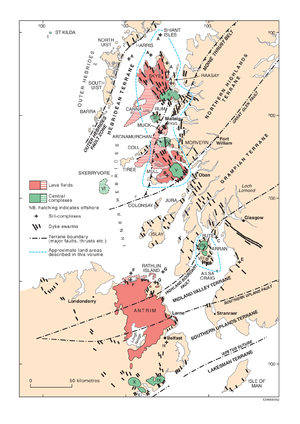Ailsa Craig Central Complex, Hebridean Igneous Province: Difference between revisions
Jump to navigation
Jump to search
No edit summary |
No edit summary |
||
| Line 1: | Line 1: | ||
{{PVDS}} | |||
__FORCETOC__ | __FORCETOC__ | ||
== Introduction == | == Introduction == | ||
Latest revision as of 11:17, 1 February 2018
| Emeleus, C H, and Bell, B R. 2005. British regional geology: The Palaeogene volcanic districts of Scotland. Fourth edition. Keyworth, Nottingham: British Geological Survey. |
Introduction

Ailsa Craig is a spectacular, conical island in the Firth of Clyde about 20 km south of Arran (P914119). It is formed by a boss of peralkaline microgranite intruded into Triassic rocks. The microgranite is characterised by riebeckitic arfvedsonite and Zr-rich aegirine (Harding, 1983; Harrison et al., 1987); aenigmatite also occurs (Howie and Walsh, 1981). This distinctive rock-type is a widespread glacial marker southwards on either side of the Irish Sea (p. 160). It has traditionally been a favoured lithology for the manufacture of curling stones (p. 173).